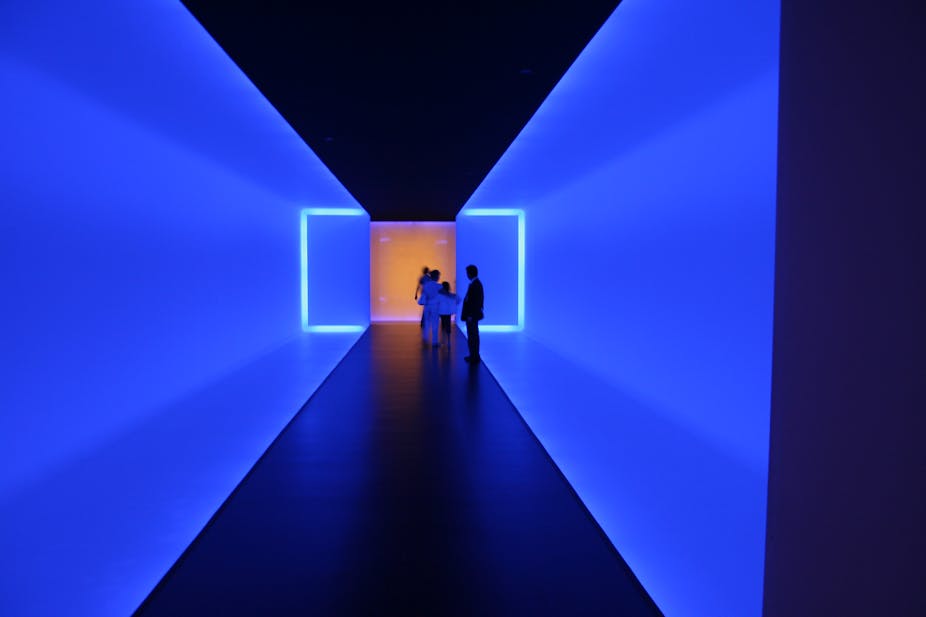James Turrell: A Retrospective opens at the National Gallery of Australia (NGA) in Canberra on December 13. The show documents the Californian-born artist’s practice over almost 50 years, including his projection pieces, built environments, holograms, drawings, prints and photographs.
While waiting for the exhibition to open, I’ve had the chance to reflect on my own encounters with Turrell’s work.
Into the Skyspace
It had been a hot and busy day. Houston, Texas, was an unexpected cultural treasure trove and the discovery of so many extraordinary galleries and artworks had delayed our departure to the outer suburb of Houston Heights, which we had to reach before sunset. On May 23, 2003, this was scheduled for 8.12pm.
When we finally arrived, the Live Oak Friends Meeting House was surrounded by a large car park, almost full. We were there to view the James Turrell Skyspace along with the congregation and the many others alerted to the magic of Turrell’s environment installations.

Turrell had created this work in the newly designed Quaker Meeting House in 2000. It attracted large numbers each Friday night to watch as the ethereal square of blue sky — revealed when the ceiling opened up silently and slowly — changed from an intense luminous cobalt to the inky Prussian of early evening.
This was my first experience of Turrell’s work, though his reputation as the Monarch of Roden Crater, a naked-eye observatory carved into a volcano on the edge of Arizona’s Painted Desert, had established him as a mythic figure in the constellation of contemporary art. I wasn’t disappointed. Sitting on the ranked benches, arching back to observe the square of sky delineated through the exquisite engineering of the razor-sharp edge of his window, I was mesmerised by the intensity of the colour.
“What is important to me is to create an experience of wordless thought,” Turrell has said. True to his Quaker heritage he was inviting us all to “Greet the Light”. Within this silent assembly, the sense of hushed awe was palpable; the slow inhaling and exhaling of breath seemed to orchestrate the pulsating square above.
Seeing the light
Much has been written about Turrell’s spirituality and the links to those earlier American masters of light and colour, the Luminists.

John Frederick Kensett, Stanford Robinson Gifford, Martin Johnson Heade, Frederick Church and Fitz Henry Lane believed it was their task to comprehend and communicate the truths that nature revealed, and Turrell does seem to be their natural heir.
Sitting in the Meeting House reinforced that spiritual connection. Indeed Heade was also a Quaker, and for the Luminist artists a study of nature was a window onto God’s handiwork. What is most evident in their paintings is the sky, presented as a vast canopy that envelops the scene and holds, somewhere close to the horizon, the shimmering orb of the sun.
The sky sets the mood of quiet contemplation and often occupies a half, almost two thirds, of the entire picture. Turrell, in his Skyspaces, reduces the field to incorporate only the sky. By framing it so precisely it becomes abstracted even further, which in the right setting, like this one, would convince even the most resolute atheist. It worked on me!
Fortunately Houston houses another major Turrell work, installed as part of the Museum of Fine Arts.
The Light Inside (1999) is a corridor that connects the museum’s two gallery buildings, the first designed by Mies van der Rohe in 1953 and a new wing designed by Raphael Moneo, opened in 2000. So the next day I joined the queue moving through this space, all of us seemingly floating on a causeway through a field of illumination that gradually shifted from blue to crimson to magenta. It was awesome, in the true sense of that word.

Since then I’ve experienced other Turrell environments, including the Skyspace he created for the National Gallery of Australia. In every one there is a sense of being lost in light, or perhaps that should be “found” in light.
As a Quaker he was told to nurture “the light within”, and in his environments Turrell gives that internal light a concrete reality. “My work is very literal and in that sense very American, It’s not about light — it is light,” he explains. “I think most of us recognise that light filling a void can be a very powerful experience — a reminder that segregating the literal and what we call the ‘spiritual’ can sometimes be a meaningless distinction.”
The opportunity to view a chronological survey of Turrell’s work is so profoundly exciting it is hard to find the words to thank Ron Radford and the team at the NGA.
What it cannot include is Roden Crater, still unfinished.

Turrell began the work of converting the dormant volcano near Flagstaff Arizona into a naked-eye astronomical observatory in 1974. When it is complete it will contain 20 spaces through which visitors will be able to encounter celestial phenomena.
It is on the top of my wish list to visit before I leave this mortal coil, but until then the NGA exhibition will fill the gap and, assuredly, build even greater expectation.
James Turrell: A Retrospective will be exhibited at the National Gallery of Australia, Canberra, from December 13 until June 8, 2015.

